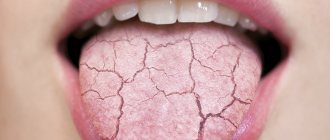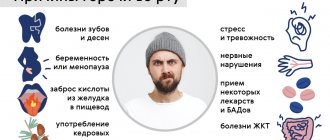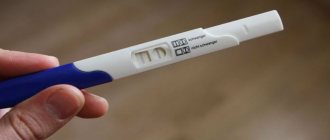Xerostomia
Xerostomia (ICD code 10 - K 11.7) is pathological dryness in the oral cavity, caused by a decrease or complete cessation of salivation. The name of the concept in Latin, Xerostomia, comes from the Greek xero- (dryness) + -stoma (mouth). This is not a separate disease, but a symptom associated with another pathological process. Xerostomia is manifested by perversion of taste sensitivity and distortion of sensations in the oral cavity.
Specialists from the Yanino-1 and Vsevolozhsk branches of the West Dental family dentistry clinic will help identify the cause of this symptom and determine the specific treatment for all signs and pathological conditions. To do this, doctors have all the necessary high-tech equipment and sterilized instruments.
What can cause salivary gland hypotension?
The causes of the disease are different, but most often it acts as a concomitant factor of another ailment, including in the oral cavity:
Constant dry mouth is often experienced by older people who take a large number of medications, especially their combinations. In this case, the disease acts as a side factor.
Dry mouth often plagues hypertensive patients, diabetics, and people with anemia associated with iron deficiency. It accompanies HIV infection, arthritis, and cystic fibrosis. The disease also develops against the background of autoimmune dysfunction in Shane's syndrome. Any virus (infectious mumps, for example) that enters the bloodstream or innervation system can become a catalyst for the development of xerostomia.
It is short-term in nature during moments of dehydration (fever, serious burns, significant blood loss, uncontrollable vomiting, diarrhea). Symptoms are pronounced in oncological diseases of the head and neck during radiation procedures.
Often, salivary dystonia occurs due to various intoxications of the central nervous system, brain injuries or tabes dorsalis.
After surgical removal of the salivary gland, the disease becomes irreversibly chronic. Therefore, the oral cavity requires constant additional hydration with special means.
With senile muscle weakness, when the lower jaw rises with difficulty, sleeping with the mouth open leads to xerostomia up to complete atrophy of the salivary gland.
In healthy people, symptoms may occur with problems associated with the nasal septum or the presence of polyps on the nasal mucosa. Frequent rinsing, especially with aggressive ingredients, will also result in a deficiency of saliva.
Causes
Many reasons lead to xerostomia, but the most basic is the use of medications, the secondary manifestation of which is dryness of the mucous membranes of the oral cavity. For temporary use, this is a harmless effect, but for a long course, an alternative should be chosen.
The main list of drugs that cause xerostomia, as one of the possible side symptoms:
- painkillers;
- muscle relaxants;
- bronchodilators;
- anticonvulsants and antitumor;
- lowering pressure;
- diuretics;
- tranquilizers.
In addition to medications in the oral cavity, xerostomia is caused by:
- diabetes;
- hypertension;
- iron deficiency;
- HIV infection;
- rheumatism;
- dysfunction of the thyroid gland;
- taking multiple medications at once;
- elderly age;
- radiation therapy;
- Sjögren's syndrome - dryness of all mucous membranes in the body.
When the nasal passages are blocked and there is a runny nose or a decrease in the tone of the soft palate, breathing at night occurs through the mouth, which is why the mucous membranes dry out in the morning. A temporary phenomenon can occur with any dehydration of the body: diarrhea, vomiting, fever, low fluid intake.
Frequent rinsing of the mouth with concentrated solutions creates all the conditions for the development of atrophy of the salivary glands and dryness of the mucous membranes.
Xerostomia: causes
As a rule, the causes of xerostomia are “hidden” not in the salivary glands themselves, but in a disease of any system of the body or a general infectious disease. This condition is mainly caused by:
- Infectious diseases: tonsillitis, tuberculosis, HIV, tonsillitis, mumps (aka “mumps”, an infectious disease of the parotid salivary glands).
- Hypertension or severe iron deficiency anemia.
- Rheumatoid arthritis, as well as some diseases of the endocrine system: thyrotoxicosis (occurs when the thyroid gland is damaged), diabetes mellitus (develops when the function of the pancreas is impaired), sialadenitis (inflammation of the salivary glands themselves).
- Head or neck injuries, constant mouth breathing due to injury to the nose or the formation of polyps in the sinuses.
- Long-term use of certain groups of medications, dehydration with prolonged fever or vomiting.
- Bad habits: drinking alcohol, smoking, drug use.
The functions of the salivary glands are not necessarily impaired in all of these diseases and conditions, but if a person has xerostomia, they will be considered as possible causes.
Classification
There are 3 stages:
- The mildest stage, in which the submandibular and parotid salivary glands function, and saliva is secreted normally. Xerostomia appears as a symptom of overwork or after a long conversation. Upon visual examination, the saliva is foamy and the mucous membrane is moist.
- The normal functioning of the salivary glands is disrupted and dryness becomes constant, diction becomes difficult. A person has difficulty eating dry food. On examination, the mucous membrane is slightly moisturized, pale and has some shine.
- At this stage, the salivary glands stop functioning. Patients pay attention to severe dryness and painful sensations of the mucous membrane. Erosive and ulcerative surfaces form in the mouth, all aggravated by stomatitis, glossitis, generalized caries and flaky lips.
What symptoms haunt a patient with xerostomia?
The symptoms of the disease are extensive:
- the appearance of fungus in the soft tissues of the oral cavity;
- modified taste and decrease in its brightness;
- constant thirst;
- difficulty swallowing;
- teeth damaged by caries;
- foul odor from the mouth;
- dry nose;
- speech disorders.
The disease is characterized by three stages. At an early stage, the “saliva factory” has difficulty coping with its functions, but with overwork or prolonged conversational stress, there is a shortage of it, and the mouth dries out. Distonated saliva foams more. At the next stage, complete salivary decompensation does not occur, and its secretion becomes irregular. During this period, problems with speech and swallowing food begin. More severe dryness is noted, the mucous membrane becomes pale pink and shiny. At the last stage, the function of the gland is seriously depressed. The manifestations of the disease become sharp: pain appears, lips dry out and peel. They may develop crusting and cracks in the corners. Ulcers appear on the inner surface of the mouth, and the likelihood of developing glossitis and stomatitis increases. The mucous membrane becomes noticeably red, and the tongue may swell.
Diagnostic measures
Diagnosis is an important step in further eliminating symptoms and curing the pathological condition. The doctor begins by collecting anamnesis and understanding what medications the patient is taking. Then an ultrasound of the salivary glands and sialography are performed. If the underlying cause of xerostomia is associated with taking a large variety of medications, then its treatment will be simple. However, after courses of radiation, it is difficult, and sometimes impossible, to fully recover. Because this technique maximally suppresses the functioning of the gland and salivation.
Clinical manifestations of xerostomia
The main symptom of xerostomia is dryness of the oral mucosa. As salivation decreases, there is a risk of purulent formations. The high probability of damage to the soft tissues of the oral cavity, including the appearance of fungal diseases, is also due to low salivation. As a result of a constant increase in dryness of the oral mucosa, the patient loses his sense of taste.
Depending on how pronounced the symptoms are, the degree of xerostomia is determined. The initial manifestation of the disease is characterized by normal salivation of the parotid and submandibular glands, due to which compensation for the production of saliva is achieved. Initial stage xerostomia manifests itself as a feeling of dryness of the oral mucosa only when the patient talks for a long time. You may also experience dry mouth as a result of overwork. During examination of the oral mucosa, its normal humidity is noted, although the saliva has foamy formations.
After the initial stage, the pathology manifests itself in the form of dysfunction of the salivary glands. Symptoms of the disease appear more clearly; therefore, the patient constantly feels dry mouth, the conversation process brings discomfort, and eating becomes difficult. The second degree of xerostomia is characterized by dry mouth even when eating, which forces patients to drink dry foods to make them easier to pass and chew. Examination shows that the oral mucosa is poorly moisturized, and the saliva is shiny with a pinkish tint.
Xerostomia of the third degree has a complete clinical picture, characterized by complete cessation of the salivary glands. A patient with this diagnosis not only feels constant dry mouth, but also experiences pain that accompanies talking and eating. The oral cavity becomes covered with herpes, stomatitis, ulcers and erosions. Upon examination, you may notice dry, flaky lips, often covered with dried crusts. Impaired function of the salivary glands with xerostomia of the third degree shows the patient has caries affecting a large number of teeth.
Also, the course of xerostomia is accompanied by a constant feeling of thirst, patients have difficulty swallowing, and there is also a characteristic bad breath. A large percentage of patients have frequent purulent throat diseases - sore throat. When the disease passes, wheezing, speech problems and a sore throat appear, causing serious discomfort. Patients have a bright red tongue, jams, and cracked corners of the mouth; viral infections appear in these places. Partial dryness in the nose, caries and periodontitis are noted.
When wearing removable dentures, there may be some difficulties with their use, and there is also the possibility of injury to the oral mucosa.
Treatment
The West Dental clinic will be able to determine how to treat xerostomia and the exact specifics of the pathological process. The disease can only be eliminated gradually by eliminating all provoking signs. Only a comprehensive approach can treat the disease, and for this, accurate diagnostic measures are important. Temporary discomfort is eliminated quickly, and the chronicity of the process is minimized by precise therapy.
To achieve a stable and favorable result, the patient must actively cooperate with the treating doctor.
Recommended:
- maintain excellent oral hygiene;
- drink plenty of fluids;
- exclude salty, spicy and sweet foods;
- to refuse from bad habits;
- use saliva-replacing rinses.
It is also possible to use folk remedies at home:
- rosehip decoctions;
- lingonberry and cranberry juices;
- infusions of chamomile, sage or calendula;
- olive oil;
- herbal sprays and gels.
Treatment and prevention
Treatment is prescribed by a dentist. Most often these are preparations that imitate saliva: gels, pastes that act as a lubricant. If the illness manifests itself situationally, it is recommended to drink water more often, suck on sugar-free candies, and take breaks in speech.
| The sooner the problem is detected, the faster, cheaper, and more painlessly it will be treated. |
To prevent this problem from leading to the development of other diseases, you need to take a very responsible approach to daily oral hygiene. Brush your teeth twice a day with a soft-bristled brush and toothpaste containing fluoride. Use brushes, dental floss, and then mouthwash.
Back
Prevention
A standard preventative measure is to drink more fluid; for an adult, the norm is 1.5-2 liters per day.
- It is necessary to stimulate constant salivation. You can suck on lollipops, chewing gum and sugar-free sweets;
- Elimination of bad habits. Minimize the consumption of alcoholic beverages and smoking. Complete refusal is preferable;
- Eat plenty of fruits and vegetables. They prevent dryness and bitterness in the mouth;
- Rinse your mouth in the morning and evening with alcohol-free solutions;
- Avoiding dehydrated foods that are high in salt.
Diagnosis of xerostomia
Xerostomia has pronounced symptoms, on the basis of which a diagnosis can be easily made, namely:
- feeling of dryness and stickiness in the mouth;
- small volume of saliva secreted;
- the consistency of saliva is thick and stretchy;
- sore throat;
- roughness, roughness and burning sensation on the tongue;
- unpleasant odor from the mouth;
- pain during talking and eating;
- disturbance of taste sensations.
In addition to interviewing the patient and external examination, the following procedures are performed to determine the degree of xerostomia:
- Sialometry is a procedure during which the amount of saliva secreted is measured. Citric acid is used as a saliva production stimulator.
- Sialography is an x-ray of the salivary glands and ducts using a contrast method. Used as a differential diagnosis to distinguish xerostomia from salivary gland stones.
- Biopsy is the collection of tissue samples from the salivary glands. It is also used as a differential diagnosis to distinguish xerostomia from malignant tumors.
Therapy to stimulate salivation
In a number of diseases, dry mouth persists for a long time, and sometimes for life. However, you can force the salivary glands to work more productively by periodically exerting an irritating, stimulating effect on them.
- Drug stimulation. Taking medications with a salivary effect as prescribed by a doctor.
- Local stimulants: chewing gum, sour candies. Their main drawback is the short duration of the result. In addition, regular consumption can be harmful to health. For example, citric acid in sour candies irritates the mucous membranes, and sugar provokes caries .
- Physiotherapeutic methods: targeted radiation of a helium-neon laser, shallow massage of the salivary glands, magnetic therapy, electrophoresis, ozokerite and therapeutic mud applications. After their exposure, the salivary glands fully or partially restore secretory activity [1, 2].
Dry mouth is caused by various etiologies, and it is impossible to make a correct diagnosis on your own. Therefore, it is very important to see a doctor as soon as possible, even if the problem only bothers you periodically. Without timely measures, your health will inevitably worsen. In addition, delay increases the risk of related problems - including the rapid development of caries, due to which you will have to become a regular patient of the dentist.
List of sources
- Pozdnyakova A. A. Features of diagnosis, clinical manifestations and correction of xerostomic syndrome in patients with diseases of the oral mucosa: dissertation. Ph.D. honey. Sciences: 01/14/14 - dentistry. Perm, 2014. // URL: https://www.psma.ru/index.php?option=com_mtree&task=att_download&link_id=22&cf_id=24 (date accessed 08/28/2020).
- Dedova L.N., Gorodetskaya O.S. Saliva: a modern view of a dentist // Belarusian State Medical University, Minsk. // URL: https://www.bsmu.by/files/475b948dcf7e198bfc2afbb9281a237f/ (accessed 08/28/2020).
- Kryukov A. I., Kunelskaya N. L., Tsarapkin G. Yu., Izotova G. N., Tovmasyan A. S., Kiseleva O. A. Symptomatic therapy of temporary xerostomia in patients after surgical interventions on the structures of the nasal cavity and pharynx // Medical advice. 2014. No. 1. P. 40–44. // URL: https://www.med-sovet.pro/jour/article/download/526/526 (accessed 08/28/2020).
How to make artificial saliva at home
Simultaneously with treatment, the condition of a person for whom a lack of saliva causes inconvenience and worsens health should be alleviated. To minimize oral dryness, doctors recommend using saliva substitutes in gel or aerosol format [3]. However, you can prepare artificial saliva yourself.
An important component of the replacement fluid is sea salt. The fact is that its aqueous solution with a concentration of 1.5–2% is pH neutral and is similar in ionic composition to blood plasma. The required amount of salt per glass of water is half a teaspoon (3-4 grams). One egg white is also added to the solution and mixed thoroughly. Rinse the mouth and throat with the resulting mixture at least 4 times a day or more often if drying occurs faster. To achieve sustainable results, the course must last at least a month [2].









